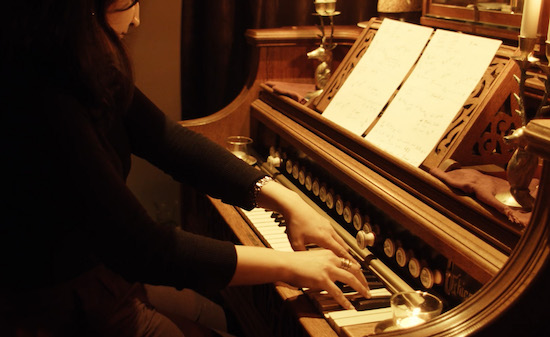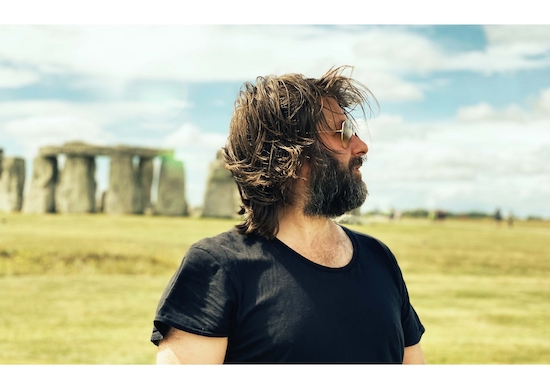Where do you begin with something that has no beginning? The drone – music characterised by the stasis of a constant tone – is so old a concept it might not be an idea at all, but simply a human refraction of the sound of the universe. It is there in the Om chant of Vedic ceremony; it is there in the music of the aulos, the double pipe of Classical Greece, which, at some 2,500 years old, is amongst the oldest readable notation in the world; it is there in the frequencies of the universe itself. A black hole in the Perseus Cluster, Harry Sword writes in Monolithic Undertow, has been recorded by scientists at Cambridge’s Institute of Astronomy; it emits a B flat. What did the Big Bang sound like? “It wasn’t really a bang at all,” a professor of physics tells Sword. “It was more of a drone than a bang.”
In some ways this feels intuitive, “like you’ve heard something you’ve never heard before, but you’ve always known,” Lee Ranaldo of Sonic Youth tells Sword. Perhaps it is. Hearing begins in the womb at around twenty weeks; those first oceanic, immersive aural experiences are surprisingly loud – around 88 decibels, the level of a food processor, Sword says. White noise is demonstrably comforting for babies and young children, in particular. It’s not hard to understand why.
Monolithic Undertow doesn’t set out to be a history of drone music; rather, Sword writes, it “follows an outer stellar orbit of sounds underpinned by the drone”. Its principal interest is the way the drone escaped from avant garde and underground music in the 1960s – and in particular the work of La Monte Young – to become, if not exactly mainstream then a mainstay of various families of broadly alternative music, from the Velvet Underground to Sunn O))), from The Stooges to Sarah Davachi.
The irony is that in early music, the drone wasn’t just mainstream, it was music. “If you put a hole in the side of a mammoth tusk, it produces the most amazingly intense drone,” archaeo-musicologist Barnaby Brown says. While western music elaborated into polyphony and counterpoint, the drone has been a constant in cultures worldwide. Sword mostly passes over its place in folk traditions – to include them would have made for a much bigger book – but, as he attests, the range of the drone’s expressiveness as used by traditions as varied as the Gyoto monks of Tibet, Gnawa music of Morocco, and the Sardinian triple-pipe launeddas – an instrument so closely related to the ancient aulos its survival seems miraculous – speaks to a kind of cultural significance that is deeper than culture.
What then does the drone speak to? I was going to write that the drone is sacred and profane at the same time, but really, that’s a category error. It is neither of those things; it predates them. The drone is one way in which humanity has learned to connect to, commune with, corral the Other – to balance our own vulnerability and transience against the immanent and eternal. “A lot of the aspects we find so graceful in ancient cultures are to do with their ability to interweave their own lives with the bigger processes they were part of,” Brian Eno tells Sword. “They had to build their lives around surrendering.” The drone has a role in ritual music that delivers repetitive rhythms and sensory excess just as it does in music of spiritual discipline and devotional austerity. Which is to say, the drone sometimes demands surrender, and sometimes merely enables it.

The Museum of Jurassic Technology, Los Angeles CA, October 2019, still from video by David Reiman
The thing to be surrendered, of course, is the self. The phrase In Search of Sonic Oblivion, which forms the book’s subtitle, refers to “the potent ability of sound – in this case slow-moving sound – to help dissolve the fragile trappings of ego”. On this reading, drone music offers not just an escape from western individualism and the social and political constrictions of 21st-century capitalism, but a way of making music that negates the egotism and posturing of other contemporary forms. A kind of liberation, in other words. In this respect, Monolithic Undertow put me in mind of a quote from turn-of-the-century psychologist William James: “Religious rapture … ontological wonder, cosmic emotion, are all unifying states of mind, in which the sand and grit of the selfhood incline to disappear … [It is] a region in which we find ourselves at home, a sea in which we swim.”
No-one did more to effect that liberation than La Monte Young, the 20th-century avant-garde composer around whom Monolithic Undertow pivots. Up until his arrival, the drone had been essentially a constant pedal note against which to play consonant or dissonant harmonies. Jazz players such as Ornette Coleman, Albert Ayler and, particularly, John Coltrane, were exploring its possibilities as they pushed at the boundaries of the familiar. But Young, schooled in the music of Webern, Stockhausen and Cage – and inspired by the Hindustani classical tradition represented by Ali Akbar Khan – stripped everything back to the pure drone itself.
Beginning in 1963, performances of his Theatre of Eternal Music ensemble – which at one point included John Cale, soon to be in the Velvet Underground, and Tony Conrad, who would work with Faust in the 1970s – were long explorations of single, sine-wave tones. Young and his wife, light artist Marian Zazeela, hummed; Conrad played violin; Cale played a viola with a flattened bridge that he’d strung with electric guitar strings. It wasn’t just the nakedness of the drone that was transformative. It was also the volume. Every element was heavily amplified. The sound, by all accounts, was overwhelming – wild, raw, and elemental – an embodiment of the romantic idea of the sublime as beauty plus terror. The drone, Young said, is “an attempt to harness eternity”; the primal is neither nice nor pretty.
The range of Sword’s listening is impressive. We have already covered a lot of ground by the time we get to Young and those you might loosely describe as his disciples: Terry Riley, Pauline Oliveros, and others. Successive chapters explore a wide range of music from the following fifty-odd years: the Velvet Underground and their successors in the New York scene down to Sonic Youth and Swans; the German kosmische musik of the late 1960s and early 1970s; hardcore; doom metal and the legacy of Black Sabbath; trance and other British electronic music of the last few decades. (That’s a very cursory summary of the breadth of the book.)
You can trace a clear line from Young to a lot of this music: through the Melvins of ‘Hung Bunny’ to Earth, say, or through Eno to some of Surgeon’s work, or Kevin Martin’s Sirens / Solitude sonic diptych. It was less clear why some of the bands in the hardcore and doom metal sections earned their place in the book – for this reader, at least. Sword’s zeal for the likes of Fu Manchu and Cathedral may or may not be well placed; it wasn’t particularly well argued in the context of drone. Sword writes in the introduction that his initial idea was for a book about doom metal; it felt a little as if material from that project hadn’t been fully integrated into the argument of this one. To put it another way, a book about the drone that devotes more pages to Electric Wizard than it does to Sonic Youth or John Coltrane seems a little out of kilter.
But elsewhere, Sword is a deeply knowledgeable and perceptive advocate for a vast range of often esoteric, sometimes challenging, always extraordinary music. I suspect a good deal of it will be unfamiliar to Monolithic Undertow’s readers. It was to me. Sword persuaded me to listen with new ears to artists such as Alice Coltrane and Glenn Branca, and to discover a whole slew of astonishing music, including that of Éliane Radigue, Cluster, Ali Akbar Khan, and Pauline Oliveros. The best of it, I think, is characterised by a devotional intensity, by turns abrasive, cathartic and serene. It feels at once both deep rooted and deeply disorienting because it disobeys all the rules of harmony and structural dynamics with which the music of the west conjures its tricks.
A lot of drone pieces are very long and the length encourages perceptual change. “If you know that the drone is absolutely constant… then you know that if you hear changing, it is you that is changing, not it,” Eno tells the author. Inside the drone, perceptions of time change too. I don’t know that Sword would go so far as to say that listening to and performing drone music is a kind of meditative practice, but the temporal pliancy of such experiences is crucial, he argues, because they allow you to take control of time, to forget the self and its sense of human transience and frailty. Reading Monolithic Undertow a phrase from a Louise Bogan poem has been running through my mind: “Music that is not meant for music’s cage”. Just as drone music offers a subversive art unconstrained by melodic, harmonic or rhythmic expectations, so it offers a release, however fleeting, from the small limits of our lives, bookended by greater oblivions as they are. It’s a portal from the body’s cage to whatever lies on the other side of ecstasy.
Monolithic Undertow by Harry Sword is published by White Rabbit Books


